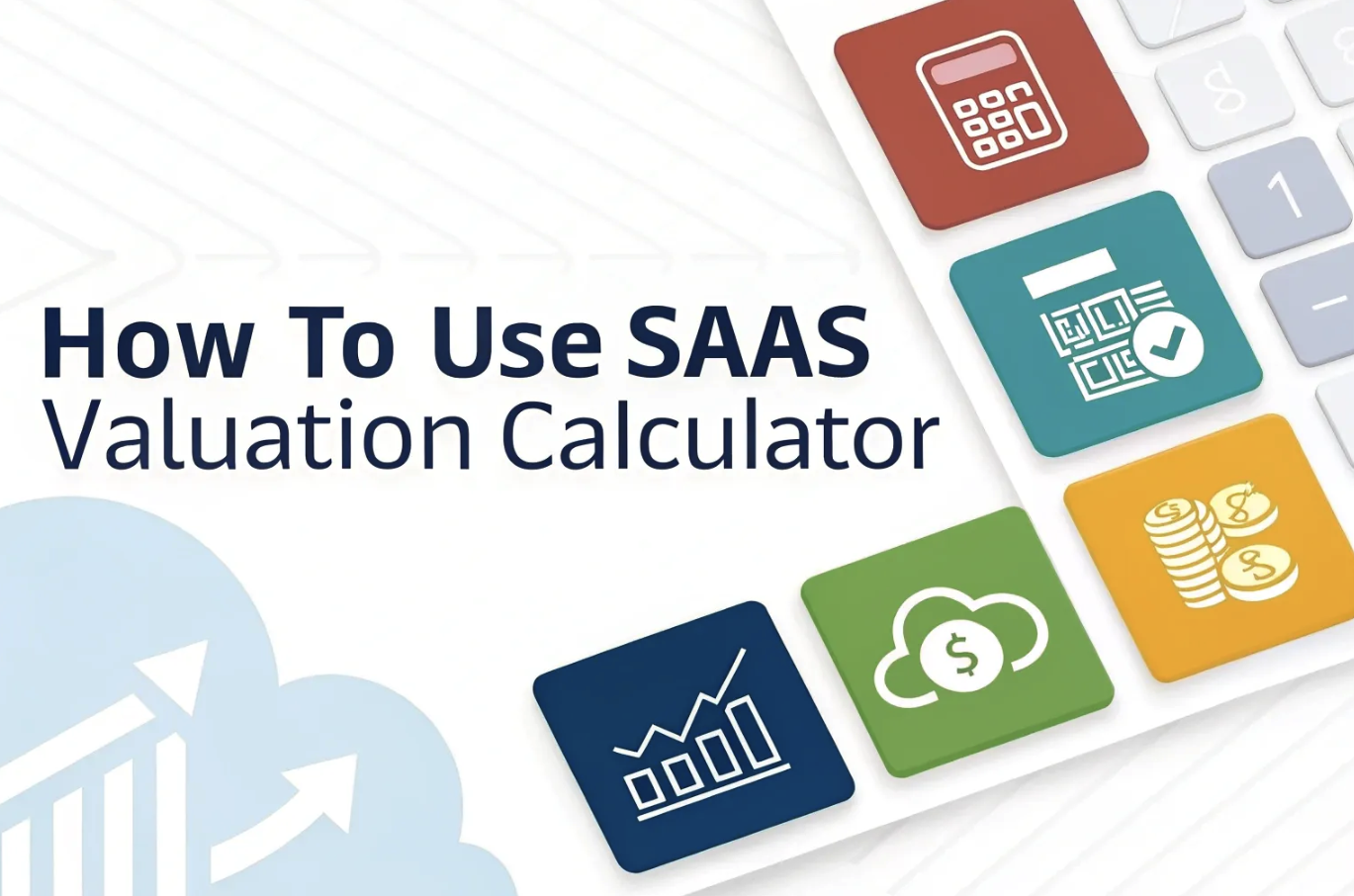
Determining the worth of a SaaS company can feel overwhelming without the right tools. Many founders struggle with challenges like understanding key metrics, comparing their business to competitors, or relying on general market valuations. These issues often lead to inaccurate assessments. A SaaS valuation calculator eliminates this guesswork. It analyzes critical data such as annual recurring revenue (ARR) and churn rate to provide a clear, actionable valuation.
Founders no longer need to rely solely on professional valuators or navigate complex calculations manually. This tool empowers rely solely on professional valuators to make informed decisions with confidence.
What is a SaaS Valuation Calculator?
Definition and Purpose
A SaaS valuation calculator is a specialized tool designed to estimate the worth of subscription businesses. It focuses on key metrics like annual recurring revenue (ARR), growth rate, and customer churn. Unlike traditional valuation methods, which often rely on complex financial modeling, this calculator simplifies the process by using data that SaaS companies already track.
Its primary purpose is to provide an accurate and actionable valuation, helping founders and investors make informed decisions. Key features that set a SaaS valuation calculator apart include:
-
Annual Recurring Revenue (ARR): The total predictable revenue generated yearly through subscriptions.
-
Customer Churn Rate: The percentage of customers who cancel their subscriptions annually.
-
Growth Rate: The speed at which ARR increases over time.
-
Profitability: The company’s net income as a percentage of its revenue.
-
Market Size: The potential customer base for the SaaS product.
-
Competition: The level of rivalry within the target market.
These features make it a go-to tool for understanding a company’s financial health and market position.
How It Simplifies Valuation
Traditional valuation methods can feel overwhelming, especially for SaaS founders without a financial background. A SaaS valuation calculator streamlines this process by breaking it into manageable steps:
-
Calculate ARR to establish a stable revenue baseline.
-
Measure growth rate to assess business expansion.
-
Identify industry valuation multiples based on market trends.
-
Multiply ARR by the valuation multiple to estimate the company’s worth.
-
Adjust for unique factors like churn rate and market competitiveness.
For example, if a SaaS company has an ARR of $2 million and an industry multiple of 6x, the estimated valuation would be $12 million. This straightforward approach saves time and reduces the risk of errors, making it accessible even for those new to financial analysis.
Why It’s Essential for SaaS Companies
SaaS businesses operate in a dynamic environment where growth and retention are critical. A SaaS valuation calculator helps founders stay ahead by offering insights into their company’s performance. It’s particularly useful for:
|
Purpose |
Description |
|---|---|
|
Investment Decisions |
Helps founders and investors evaluate whether a company is worth funding. |
|
Benchmarking |
Allows comparison with competitors to identify strengths and weaknesses. |
|
Strategic Planning |
Provides data-driven insights for setting goals and scaling operations. |
Without this tool, subscription businesses risk relying on outdated or inaccurate methods, which can lead to poor decision-making. A SaaS valuation calculator empowers companies to focus on growth while maintaining financial clarity.
Key Metrics to Calculate SaaS Value
Annual Recurring Revenue (ARR)
When I calculate SaaS value, the first metric I examine is Annual Recurring Revenue (ARR). ARR represents the predictable revenue a company generates annually from its subscription-based services. It’s a cornerstone for understanding a SaaS company’s financial health.
Investors and buyers often prioritize ARR because it directly impacts valuation. For instance, valuers use ARR to assess a company’s worth by applying industry-specific multiples.
Here’s a quick look at average ARR multiples across various SaaS industries:
|
SaaS Industry |
Average ARR Multiple |
|---|---|
|
AdTech |
5.8x |
|
CRM |
6.7x |
|
Cybersecurity |
7.1x |
|
E-Commerce |
7.7x |
|
ERP |
8x |
A higher ARR signals a more valuable asset, especially when trends show consistent growth. It also reflects the quality of a company’s customer base. A diverse and stable customer portfolio enhances ARR’s impact on valuation, making the business more appealing to investors.
Growth Rate
Growth rate is another critical metric for SaaS companies. It measures how quickly revenue increases over time. A high growth rate often indicates strong market demand and effective business strategies. For example, the top quartile of SaaS companies grows at 60-70% annually, while the median growth rate is around 30%.
I’ve noticed that the growth rate directly correlates with valuation. A higher growth rate suggests future revenue potential, which attracts investors. However, it’s essential to evaluate growth alongside other metrics like churn rate.
A company growing at 70% annually but losing customers rapidly might face challenges sustaining its valuation.
Net Revenue Retention (NRR)
Net Revenue Retention (NRR) reveals how well a SaaS company retains and expands revenue from its existing customers. It’s calculated as the percentage of recurring revenue retained over a specific period, including upsells and cross-sells.
A strong NRR indicates product stickiness and customer satisfaction.
The average NRR for SaaS companies is approximately 100%. Enterprise SaaS businesses often achieve 125%, while smaller companies target around 90%. Higher NRR reduces investor risk and boosts valuation multiples. When I analyze NRR, I see it as a reflection of a company’s ability to grow without relying solely on new customer acquisition.
Customer Churn Rate
Customer churn rate is one of the most critical metrics for any SaaS business. It measures the percentage of customers who cancel their subscriptions over a specific period. A high churn rate signals potential issues with customer satisfaction, product fit, or pricing strategy.
When I evaluate a SaaS company, I always consider churn as a key indicator of long-term sustainability.
The average churn rate across SaaS companies is 4.1%, with voluntary churn (customers choosing to leave) accounting for 3.0% and involuntary churn (payment failures or other issues) making up 1.1%. For established SaaS businesses, a monthly churn rate of 4% or less is a good benchmark.
Companies with higher average revenue per user (ARPU) often experience lower churn rates. For instance:
-
Companies with an ARPU of $10 or less have a churn rate of 6.2%.
-
Those with an ARPU between $100-$250 see churn rates around 7.1%.
-
The highest churn rates, 8.7%, occur in companies with an ARPU between $25-$50.
Churn directly impacts valuation. A 1-2% difference in churn can result in a 12% increase in valuation over five years.
For example, a SaaS company with a 5% churn rate might achieve a valuation of $57.4 million after five years, while a 15% churn rate could drop that figure to $27.4 million. This demonstrates how reducing churn not only improves customer retention but also significantly boosts a company’s worth.
Gross Margin
Gross margin is another essential metric for SaaS companies. It represents the percentage of revenue remaining after accounting for the cost of goods sold (COGS). A high gross margin indicates efficient operations and a scalable business model. When I analyze SaaS companies, I look for margins above 75%, as these businesses tend to outperform their peers.
Most privately held SaaS companies maintain gross margins between 70% and 85%. Margins below 70% often require further investigation into product delivery costs or pricing strategies. Here’s a breakdown of gross margin benchmarks:
|
Metric |
Value Range |
|---|---|
|
Average Gross Margin |
70% to 85% |
|
Good Gross Margin |
75% and above |
|
Best-in-Class Margin |
At least 80% |
Gross margin plays a significant role in valuation. Higher margins mean more resources for reinvestment in growth, such as marketing, product development, or customer success initiatives. For SaaS companies, maintaining a strong gross margin is crucial for attracting investors and achieving sustainable growth.
How to Use a SaaS Valuation Calculator
Inputting Key Metrics
When using a SaaS valuation calculator, the first step is to input accurate data. I always recommend starting with these key metrics:
-
Identify your Annual Recurring Revenue (ARR): Calculate the total predictable revenue your SaaS business generates annually. For example, if your monthly recurring revenue (MRR) is $50,000, your ARR would be $50,000 × 12 = $600,000.
-
Determine your ARR Multiple: This value reflects what investors might pay per dollar of ARR. It varies based on growth rate and market trends. For instance, a fast-growing SaaS company might have a multiple of 8, while a mature one might have 4.
-
Calculate the SaaS Valuation: Multiply your ARR by the ARR Multiple. For example, with an ARR of $600,000 and a multiple of 6, the valuation would be $600,000 × 6 = $3,600,000.
Accurate inputs are essential. Overlooking metrics like customer acquisition cost or churn rate can lead to misleading results. I always double-check my data to ensure that the valuation accurately reflects the business’s true financial health.
Example Calculation
Let me walk you through a detailed example to calculate SaaS value. Imagine a SaaS company with the following metrics:
-
Annual Recurring Revenue (ARR): $1,000,000 (calculated as MRR × 10).
-
Growth Rate: 50%.
-
Industry Valuation Multiple: 8.
Here’s how I would calculate the valuation:
-
Project next year’s ARR: Multiply the current ARR by (1 + Growth Rate). In this case, $1,000,000 × (1 + 0.5) = $1,500,000.
-
Apply the revenue multiple: Multiply the projected ARR by the valuation multiple. $1,500,000 × 8 = $12,000,000.
This example shows how growth rate and ARR influence the final valuation. Adjustments for factors like churn or customer lifetime value can further refine the estimate.
Interpreting the Results
Once the calculator provides a valuation, I analyze the results to understand the company’s financial position. A high valuation often indicates strong ARR, low churn, and efficient operations. However, I also consider other factors:
-
Sustainability: Does the growth rate align with market trends?
-
Profitability: Are gross margins above 75%?
-
Customer Metrics: Is the customer acquisition cost reasonable compared to customer lifetime value?
For example, if the valuation is $12,000,000 but the churn rate is high, I would investigate retention strategies. A SaaS valuation calculator simplifies the process, but interpreting the results requires a deeper understanding of the business metrics.
Factors That Impact SaaS Valuation
The Role of ARR and Growth Rate
When I calculate SaaS value, I always start with Annual Recurring Revenue (ARR) and growth rate. These two metrics form the foundation of any valuation. ARR reflects the stability and predictability of a company’s revenue. It shows how much revenue the business generates annually from subscriptions.
Growth rate, on the other hand, highlights how quickly the company is expanding. Together, they provide a clear picture of the company’s financial health and future potential.
Here’s a quick breakdown of their impact:
|
Metric |
Description |
|---|---|
|
ARR’s Role |
ARR indicates revenue stability and directly influences the purchase price. |
|
Growth Rate’s Impact |
A high growth rate signals strong market demand, leading to higher valuations. |
For example, a SaaS company with an ARR of $2 million and a growth rate of 50% will likely attract more investor interest than one with stagnant growth. Investors see these metrics as indicators of success and scalability.
Importance of Retention and Churn
Retention and churn rate play a critical role in determining long-term value. A high churn rate often signals deeper issues, such as poor product-market fit or low customer satisfaction. It also increases the cost of acquiring new customers, which can hurt profitability. On the flip side, high retention rates create stable revenue streams that investors find appealing.
I’ve seen how even small changes in churn rate can significantly impact valuation. For instance:
-
A 1-2% improvement in churn rate can boost valuation by 12% over five years.
-
High churn rates often lead to revenue instability, making the company less attractive to investors.
Retention strategies, like improving customer onboarding or enhancing product features, can lower churn and increase customer lifetime value. These efforts not only stabilize revenue but also make the business more sustainable.
Profitability and Market Trends
Profitability and market trends also influence SaaS valuations. Companies with high gross margins and efficient operations tend to attract higher valuations. For SaaS businesses, maintaining a gross margin of 75% or higher is ideal. This demonstrates that the company can reinvest in growth without compromising its profitability.
Market trends add another layer of complexity. Economic growth often boosts investor confidence, leading to higher valuations. Conversely, downturns can make investors cautious, lowering valuations. I’ve noticed that external factors, like competition, also play a role.
A crowded market can force companies to lower prices, which impacts revenue and valuation.
Understanding these factors helps SaaS founders navigate the valuation process more effectively. Monitoring market conditions and optimizing profitability ensures the company remains an attractive investment opportunity.
Benefits of Using a SaaS Valuation Calculator
Saves Time and Effort
When I use a SaaS valuation calculator, I immediately notice how much time it saves. Traditional valuation methods often involve complex financial modeling and lengthy consultations with professionals. These processes can take weeks or even months.
A SaaS valuation calculator simplifies this by providing quick results based on key metrics like ARR and churn rate. This efficiency enables me to focus on other critical aspects of running a business, such as enhancing the customer experience or refining product offerings. The tool also reduces the effort required to gather and analyze data.
Instead of manually calculating metrics like customer acquisition cost or customer lifetime value, I can input the data into the calculator and get instant insights. This streamlined process makes it easier to evaluate a company’s worth without needing extensive financial expertise.
Provides Accurate Estimates
SaaS valuation calculators offer reliable estimates by using standard industry methods and benchmarks. While no automated tool can fully replace a professional valuation, these calculators provide a solid starting point for accurate valuation. They analyze data like growth rate and market conditions to deliver results that align closely with traditional methods.
However, I always recommend combining the calculator’s output with expert advice for a more comprehensive understanding.
The accuracy of these tools depends on the quality of the data entered. For example, if I input precise ARR and churn rate figures, the calculator can produce highly relevant estimates. This accuracy helps me make informed decisions, whether I’m planning to attract investors or exploring non-dilutive capital options to maintain ownership.
Supports Strategic Growth Decisions
Understanding a company’s valuation is crucial for strategic planning. When I know the worth of a SaaS business, I can set realistic goals and develop effective growth strategies.
For instance, if the valuation highlights a high churn rate, I can prioritize retention efforts to stabilize revenue and increase customer lifetime value.
These calculators also help in making investment decisions. Knowing the valuation allows me to identify areas that need improvement, such as optimizing gross margins or enhancing product features. This data-driven approach ensures that every decision supports long-term growth and sustainability.
While the calculator provides a strong foundation, I often consult financial experts for deeper insights, especially when planning significant business moves.
A SaaS valuation calculator offers SaaS founders and investors a reliable way to assess a company’s worth. It simplifies complex financial evaluations by focusing on actionable metrics like ARR, growth rate, and churn. When using this tool, I always keep these key takeaways in mind:
-
Adjust revenue multiples based on growth rates and profitability.
-
Avoid overreliance on a single valuation method.
-
Consider market conditions and future growth potential.
-
Focus on reducing churn and improving gross margins.
These insights help me make informed decisions and identify areas for improvement. For instance, enhancing customer experience or optimizing pricing strategies can significantly boost valuation.
Start leveraging a SaaS valuation calculator today to unlock your company’s growth potential and attract investor confidence.



